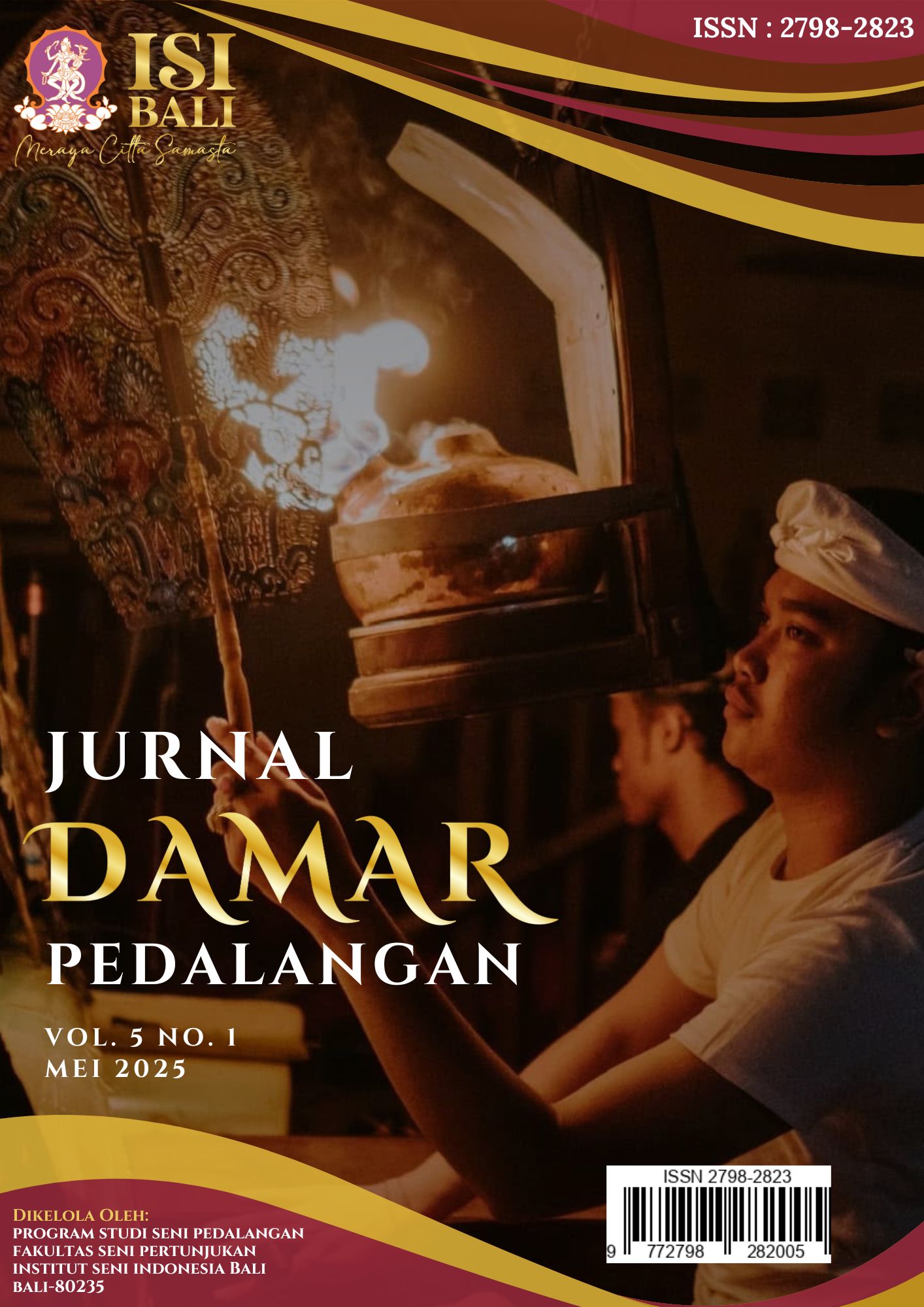PRODUKSI KARYA TEATER PAKELIRAN “BIBI ANU”
DOI:
https://doi.org/10.59997/dmr.v5i1.4886Keywords:
Bali, Bibi Anu, Pakeliran TheaterAbstract
The Pakeliran Theater "Bibi Anu" explores the theme of land uncertainty in Bali caused by ongoing land conversion, highlighting the conflict between tradition and modernization that impacts the cultural identity of the Balinese people. The title "Bibi Anu" carries a profound philosophical meaning, with "Bibi" symbolizing a mother as the guardian of life, and "Anu" reflecting the ambiguity of social changes. This work merges puppetry art and theater, following a creative process consisting of three stages: exploration, improvisation, and formation. Each stage reflects the evolving relationship between humans and the land, from harmony with nature to the crisis triggered by rapid social transformations. The performance is divided into three acts, each with significant meaning. The first act portrays harmony between humans and nature based on the Tri Hita Karana principle, which emphasizes balance between humans, God, and nature. The second act examines the shift in traditional values due to tourism, altering the way of life in Bali. The third act focuses on the emotional crisis resulting from the disconnection between people and the land, leading to feelings of loss and anxiety. This work invites critical reflection on the challenge of preserving tradition amid modernization. "Bibi Anu" fosters dialogue on social and environmental changes in Bali, exploring the complex relationship between humans, culture, and nature in a rapidly changing world.
Downloads
References
[1] W. Widia, sumiyati dan G. Sedana, “Aspek Ritual pada Sistem Irigasi Subak,” Jurnal Kajian Bali (Journal of Bali Studies), vol. 5, no. 1, pp. 23-56, 2015.
[2] G. A. Soetama, Dari Bule Jadi Bali, Denpasar: Buku Arti, 2010.
[3] H. H. Wicaksono dan Q. N. Wijayani, “Kritik Sosial Melalui Kesenian: Analisis Mahasiswa Universitas,” Harmoni : Jurnal Ilmu Komunikasi dan Sosial , vol. 2, no. 1, pp. 22-30, 2024.
[4] Y. S. Hadi, Mencitpta Lewar Tari, Yogyakarta: Manthili, 2003.
[5] D. Sugono dan Y. Maryani, Kamus Bahasa Indonesia, Jakarta: Tim Penyusun Kamus Pusat Bahasa, 2008.
[6] S. N. G. A. S. I. D. K. W. I. G. M. D. P. I Dewa Ketut WIcaksandita, “Nilai-Nilai Estetika Hindu Wayang Kulit Bali: Studi Kasus Internalisasi Jana kertih Melalui Karakter Tokoh Pandawa, Sebagai Media Representasi Ideal Manusia Unggul,” Jurnal Damar Pedalangan, vol. 4, no. 1, pp. 63-80, 2024.
[7] I. G. M. D. Putra, “Problematika Teater Pakeliran sebagai Konsep Garap dalam Seni Pewayangan,” Panggung, vol. 31, no. 3, pp. 386-400, 2021.
[8] R. A. Safitri dan A. Pramitasari, “Ambiguitas dalam konten kanal YouTube Najwa Shihab,” Prosiding Konfrensi Ilmiah Pendidikan, vol. 5, no. 1, pp. 71-79, 2024.
[9] J. Sumardjo, Filsafat Seni, Bandung: ITB , 2000.
[10] N. Sirtha, Subak: Konsep Pertanian Religius Perpektif Hukum, Budaya, dan Agama Hindu, Surabaya: Paramita, 2007.
[11] G. A. Soethama, Selalu Rindu Bali, Denpasar: Prasasti, 2019.
[12] G. A. Soethama, Mandi Api, Denpasar: Prasasti, 2006.
[13] Kemendikbud, Panduan Implementasi Merdeka Belajar Kampus Merdeka, Jakarta: Kementerian Pendidikan dan Kebudayaan, 2020.
[14] I. K. Setiawan, “Kebertahanan Subak di Desa Kedewatan Ubud, di Tengah-Tengah Arus Pariwisata Global,” Pustaka Jurnal Ilmu-Ilmu Budaya, vol. 19, no. 2, pp. 107-111, 2019.
[15] S. Suparlan, “Keterampilan Membaca Pada Pembelajaran Bahasa Indonesia di SD/MI,” FONDATIA, vol. 5, no. 1, pp. 1-12, 2021.
[16] B. Murtiyoso, Pengetahuan pedalangan, Surakarta: Sub Proyek Pengembangan ASKI, 1983.
[17] Darmoko, “Seni Gerak Dalam Pertunjukan Wayang Tinjauan Estetika,” Makara Human Behavior Studies in Asia, vol. 8, no. 2, pp. 83-89, 2004.
[18] A. Ahmadi, Laporan Penelitian Kreatifitas Karya Kriya Kulit Pengembangan Wayang Kulit Purwa, Surakarta: ISI Surakarta, 2015.
[19] E. Elpasa, I. Ismunandar dan A. Muniir, “KAJIAN MUSIKOLOGI MUSIK IRINGAN TARI JEPIN KERIS KARYA YUZA YANIS CHANIAGO,” Jurnal Pendidikan dan Pembelajaran Khatulistiwa, vol. 7, no. 5, 2018.
Downloads
Published
Issue
Section
License
Copyright (c) 2025 Arta Wiguna I Made, I Ketut Sudiana, I Dewa Ketut Wicaksandita

This work is licensed under a Creative Commons Attribution 4.0 International License.


